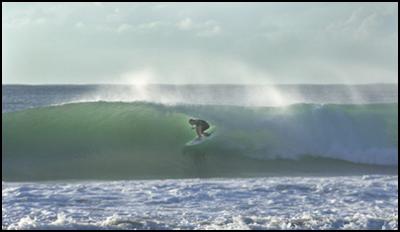Knowledge about iconic local surf breaks to be collected
Knowledge about iconic local surf breaks to be collected
Gisborne District Council wants to talk to locals who know the district’s surf breaks best.
A study by Lincoln University student, Bailey Peryman is underway to find out about makes Tairāwhiti’s great surf breaks work. He will be focusing on the six breaks that were recently registered as nationally significant as well as others that are particularly well known and loved by the local surfing community.

“I will be meeting informally with surfers who understand how the break works from a surfers point of view,” says Mr Peryman. “I want to understand what influences the quality of the surfing experience at specific breaks and why surfers value those breaks.”
Under the New Zealand Coastal Policy Statement Council now needs to protect our best surf breaks when developing regional plans or making decisions on coastal development. This requirement came into effect earlier this month.
Council must ensure that what is done on or near the beach doesn’t have a negative impact on the use or enjoyment of a surf break. Activities that could impact on a particular break may include sand removal, rock protection work, aquaculture, stormwater management or even sand dune planting.
“A well publicised example of development arguably having a negative effect on a surf break is the Whangamata Marina,” says Mr Peryman. “Constructing the marina has involved the removal of thousands of cubic metres of sand one kilometre from the famous ‘Whangamata Bar’ surf break.”
“Waves break along a sand bottom at this spot and it is vulnerable to developments such as the marina. By understanding that the Whanagmata Bar is sand break we can see that sand removal will affect it. If it was a reef break then sand removal may not be such an issue.”
Once Mr Peryman has completed his study, Council staff will use the information to consider management options for breaks in conjunction with surfers and the wider community. This is a key part of Council ensuring it can meet the requirements of the NZ Coastal Policy Statement related to protecting surfbreaks.
Anyone with in-depth knowledge and experience of any surf break in the Gisborne/ East Coast region who would like to share their knowledge is asked to contact Council’s Yvette Kinsella. Email yvette[at]gdc.govt.nz or call 8** 2049.
Three of the Gisborne surf breaks registered as nationally significant in the National Coastal Policy Statement are at Wainui Beach; Stock Route, Pines and Whales. Two are at Makorori; the Point and Centres and one at Sponge Bay Island.
ENDS


 New Zealand Open: Ryan Hits Peake With New Zealand Open Victory
New Zealand Open: Ryan Hits Peake With New Zealand Open Victory Ministry For Culture And Heritage: Children's Day - New Research Shows NZ Rangatahi Positively Affected By Participating In Arts, Culture & Recreation
Ministry For Culture And Heritage: Children's Day - New Research Shows NZ Rangatahi Positively Affected By Participating In Arts, Culture & Recreation Otago Museum: Tūhura Otago Museum Unveils Iconic Display Dedicated To Martin Phillipps And The Chills
Otago Museum: Tūhura Otago Museum Unveils Iconic Display Dedicated To Martin Phillipps And The Chills  Hauora Taiwhenua Rural Health Network: Hauora Taiwhenua Presents 10-Point Action Plan For Rural Māori Health
Hauora Taiwhenua Rural Health Network: Hauora Taiwhenua Presents 10-Point Action Plan For Rural Māori Health PHCC: Youth Vaping Declines Slightly But Still High By Global Standards
PHCC: Youth Vaping Declines Slightly But Still High By Global Standards NZEI Te Riu Roa: Hoardings Go Up, Petition Signed As Early Childhood Teachers Wait For Proposed Reforms To Hit Cabinet
NZEI Te Riu Roa: Hoardings Go Up, Petition Signed As Early Childhood Teachers Wait For Proposed Reforms To Hit Cabinet